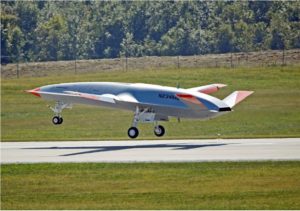Navy officials told the Government Accountability Office (GAO) the MQ-25A Stingray unmanned aerial tanker developmental schedule might be delayed by three years and increase program costs if the Navy misses windows to install the aircraft on aircraft carriers.
The GAO’s latest annual Defense Acquisition Annual Assessment, published June 3, said Navy program officials told them the service’s potential inability to maintain its schedule commitments for the MQ-25 may require modifications to the contract which would impact the fixed price terms.

“Specifically, the Navy faces limited flexibility to install MQ-25 control centers on aircraft carriers. If the Navy misses any of its planned installation windows, the program would have to extend MQ-25 development testing by up to 3 years. According to officials, such a delay could necessitate a delay to initial capability and result in a cost increase,” the GAO said.
The MQ-25 is being developed and built by Boeing [BA] as a carrier-based aerial refueler that also will have limited intelligence, surveillance and reconnaissance capabilities. The Navy plans to ultimately procure 72 aircraft after the initial four engineering and manufacturing development (EMD) aircraft.
Boeing’s test aircraft, T-1, conducted its first autonomous test flight last September (Defense Daily, Sept. 20, 2019).
The Navy currently plans to have the first EMD aircraft ready by 2021, with carrier-based tests during sea trials planned for 2022-23 and initial operational capability in 2024.
Last August the, Navy’s issued a budgetary appeal to the FY 2020 House defense appropriations bill, warning plans to cut the Unmanned Carrier Mission Control System by $52 million would delay funding systems on aircraft carriers to launch and recover the unmanned aircraft (Defense Daily, Aug. 14, 2019).
The Navy argued the cut represented a 72 percent reduction, eliminating three of four planned carrier installations, delay integrating launch and recovery systems by 17 months, and limit air vehicle testing to only one of the carrier’s at-sea periods.
Boeing first won an $805 million EMD contract in 2018 as the first step in procuring the MQ-25 fleet (Defense Daily, Aug. 30, 2018).
The GAO report noted this was a ceiling price for the base, fixed-price incentive development effort and was much lower than the Navy’s initial development cost estimate.
“According to program officials, the Navy anticipated the submission of strategic low pricing for this contract because of investments made prior to development award.”
The EMD contract covers the first four development aircraft and options for three more, but does not cover options for the planned 69 production aircraft.
GAO said Navy officials explained the company “will provide cost, technical, and programmatic data during the development phase, which the Navy intends to use to help it negotiate the planned sole source award to Boeing for the production aircraft.”
The report said the Navy scheduled a production decision for 69 MQ-25s for February 2023, eight months ahead of what GAO reported in its 2019 report. Twelve of the aircraft are set to be low-rate initial production aircraft.
The Navy told the office this bump in timing was the result of a program review of the schedule Boeing provided the Navy in 2018, after being awarded the development contract.
“Program officials acknowledged the schedule is aggressive, but stated that they believe it is achievable,” GAO said.